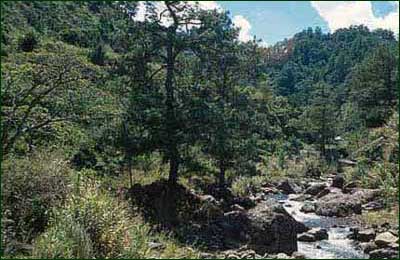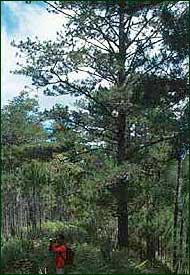Philippine Pines
Many Filipinos share fond memories of vacations in Baguio City, the "summer capital of the Philippines," where the cool climate and beautiful scenery bring relief from the oppressive heat in the lowlands. Baguio is in Benguet Province in the Central Cordillera, the mountain range that forms the backbone of northern Luzon. On these mountains, pine trees are the dominant vegetation. Easily recognized by their pyramidal shape, their needle-like leaves grouped in bunches of two or three, and woody cones, two species of pine are native to the Philippines: the familiar Benguet pine or saleng (Pinus insularis) and the obscure Mindoro pine or tapulao(Pinus merkusii).
The Benguet pine grows in the highlands of central and northern Luzon, and is dominant in Mountain Province from 1,000 to 2,500 meters elevation. During the Spanish colonial period, the pine's resin was an important commercial source of turpentine. The tree reaches a height of 40 meters and a diameter of 140 centimeters. The trunk is straight and the crown narrow, with short lateral branches.
The Mindoro pine is found in the Zambales peninsula of Luzonand in northwestern Mindoro. In its namesake region it occurs in pure stands even at low altitudes. The tree reaches a height of 25 meters anddiameter of about 90 centimeters. The chief difference between the Mindoro and Benguet pines is that the needles of the former occur in groups of two while the needles of the latter develop in groups three.
Both species are widely distributed from the Himalayas and Burma to the Philippines, suggesting that the Philippine populations were dispersed from mainland Asia. There is considerable evidence that nearly the whole area now occupied by pines in the Philippines was formerly occupied by broad-leaved trees and shrubs. Yet a walk through the pine forest reveals that the ground is most often covered with grass while broad-leaved trees and shrubs are confined to moist ravines. The reason is that pines and grasses can withstandrepeated fires, often man-made, that kill off broad-leaved trees and shrubs.
Original URL: http://archive.fieldmuseum.org/vanishing_treasures/V_Pines.htm


